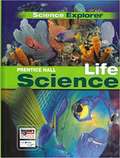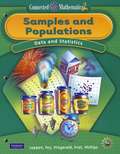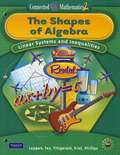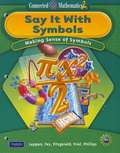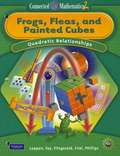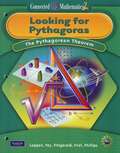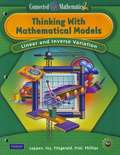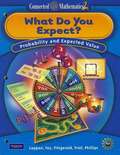- Table View
- List View
Prentice Hall Literature Michigan, Language and Literacy [Grade 7]
by Pearson EducationNIMAC-sourced textbook
Prentice Hall Science Explorer Life Science
by Michael J. Padilla Ioannis Miaoulis Martha CyrNIMAC-source textbook
Science Explorer: Life Science (National Edition)
by Jan Jenner Linda Cronin Jones Elizabeth Coolidge-Stolz Marilyn LisowskiLife Science textbook for Grade 7
Prentice Hall Science Explorer Earth Science
by Jay M. Pasachoff Jan Jenner Andrew C. Kemp Barbara Brooks SimonsNIMAC-sourced textbook
Prentice Hall Science Explorer: Earth Science
by Prentice HallPrentice Hall Science Explorer: Earth Science contains unit lessons on Exploring Planet Earth, Earth's Changing Surface, Earth's Waters, Weather and Climate, and Astronomy.
Prentice Hall Literature 2010: All-in-One Workbook (Grade #7)
by Prentice HallWorkbook to accompany a language arts textbook.
Prentice Hall Literature Language and Literacy [Grade 7](Georgia)
by Pearson EducationPrentice Hall Georgia Literature
Prentice Hall Literature, Penguin Edition: Reader's Notebook (Grade 7, Adapted Version)
by Prentice HallAs you read your student edition of Prentice Hall Literature, use the Reader's Notebook to guide you in learning and practicing the skills presented. In, addition, many selections in your student edition are presented here in an interactive format. The notes and instruction will guide you in applying reading and literary skills and in thinking about the selection.
Prentice Hall Literature: Readers Notebook
by Prentice HallPearson Prentice Hall Literature is an engaging program that reaches all students through personalized instruction. Highly engaging visuals and contemporary lesson designs have been carefully crafted into the program to ensure students will be easily engaged and stay highly motivated as they experience outstanding literature, poetry, and contemporary media. Prentice Hall Literature includes explicit instruction of skills--reading, vocabulary, literary analysis, and writing conventions--all in the context of the literature students read. Prentice Hall Literature is organized around big and essential questions based on the Understanding by Design model by Grant Wiggins. Students frequently revisit these questions throughout lesson activities to deepen their understanding of universal themes. The Understanding by Design model helps you deliver focused instruction by teaching skills in context rather than in isolation. Prentice Hall Literature Student Edition includes Informational Texts, Comparing Literary Works, Writing Workshops, and end-of-unit activities. Every unit is hosted by an award-winning contemporary author, and the instruction targets specific reading strategies. The unit introduction includes introducing the Big Question and the unit genre and author. This "Big Question" section helps to to get you and your child thinking about important ideas to guide reading. The literature includes both classic and contemporary selections and the Informational Texts feature has students applying learned skills to real-life. Reader's Notebook - Interactive workbooks with targeted reading and skill support for every selection in the student edition, plus additional full-length selections: Interactive reading, literary analysis, and vocabulary support Selection summaries and guides for note-taking Sentence starters for reading-writing connections "Turbo" vocabulary building tools "Big Question" writing activities All-in-One Workbook - Skills and assessment practice for all students, the All-in-One provides: Practice with reading skills, grammar, vocabulary, and literary analysis Writing support Test practice Fluency practice
Prentice Hall Literature Florida, Language and Literacy [Grade 7]
by Pearson EducationNIMAC-sourced textbook
Pearson Literature California, Reading and Language [Grade 7]
by Pearson EducationNIMAC-sourced textbook
Pearson Literature: Reading and Language (Grade 7, California Edition)
by PearsonThe California program advisors provided input during the development of Pearson Literature. Their valuable insights ensure that the perspectives of the teachers throughout the state are represented within the literature series.
Samples and Populations, Data and Statistics
by Glenda Lappan James T. Fey William M. FitzgeraldNIMAC-sourced textbook
The Shapes of Algebra, Linear Systems and Inequalities
by Glenda Lappan James T. Fey William M. Fitzgerald Susan N. Friel Elizabeth Difanis PhillipsNIMAC-sourced textbook
Say It With Symbols, Making Sense of Symbols
by Glenda Lappan James T. Fey William M. FitzgeraldNIMAC-sourced textbook
Kaleidoscopes, Hubcaps, and Mirrors, Symmetry and Transformations
by Glenda Lappan James T. Fey William M. FitzgeraldNIMAC-sourced textbook
Frogs, Fleas, and Painted Cubes, Quadratic Relationships
by Glenda Lappan James T. Fey William M. FitzgeraldNIMAC-sourced textbook
Growing, Growing, Growing, Exponential Relationships
by Glenda Lappan James T. Fey William M. Fitzgerald Susan N. Friel Elizabeth Difanis PhillipsNIMAC-sourced textbook
Looking for Pythagoras, The Pythagorean Theorem
by Glenda Lappan James T. Fey William M. Fitzgerald Susan N. Friel Elizabeth Difanis PhillipsNIMAC-sourced textbook
Thinking With Mathematical Models, Linear and Inverse Variation
by Glenda Lappan James T. Fey William M. Fitzgerald Susan N. Friel Elizabeth Difanis PhillipsNIMAC-sourced textbook

